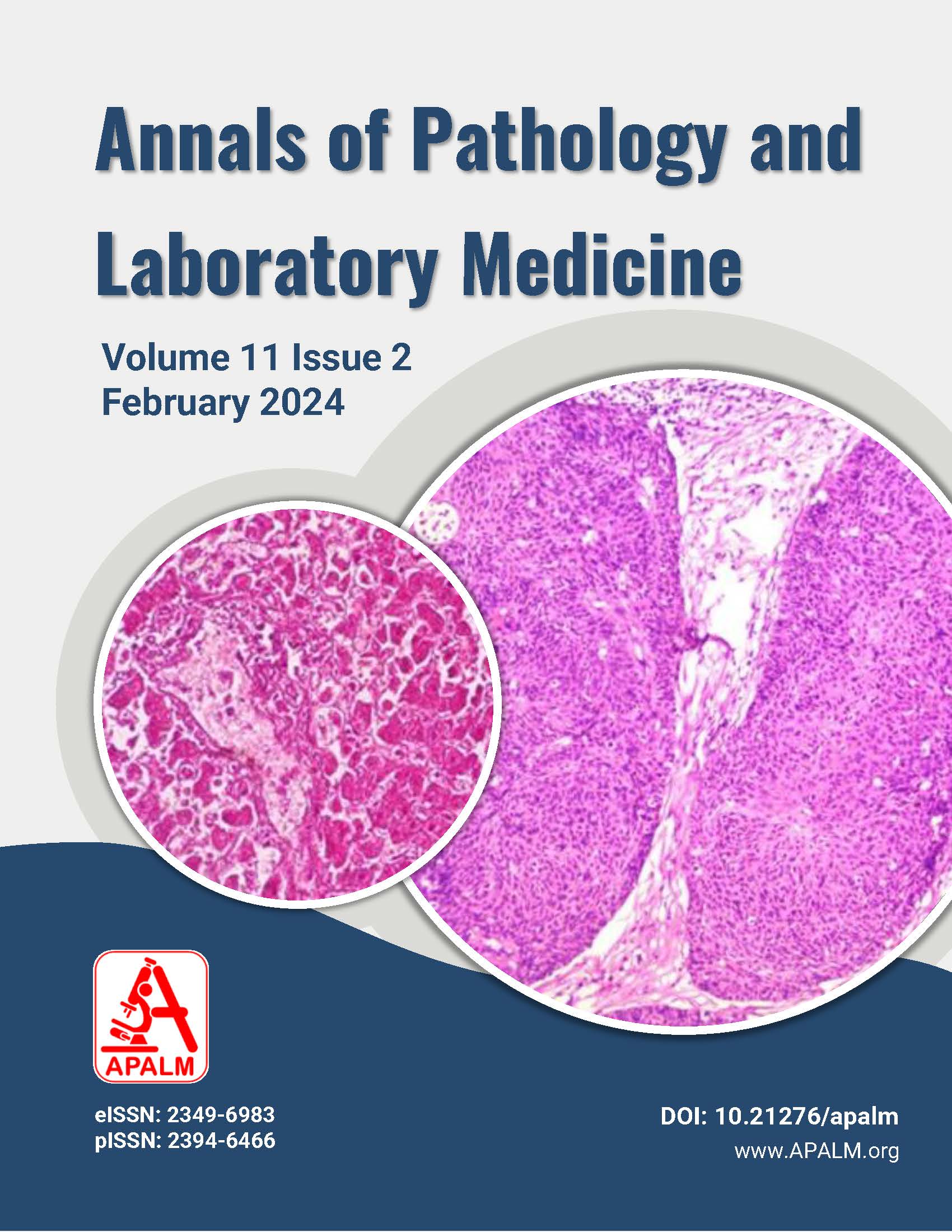Dealing with Rare Beta Chain Hb Variants — Diagnostic Dilemmas
DOI:
https://doi.org/10.21276/apalm.3288Keywords:
Capillary electrophoresis, Hb Hope, High performance liquid chromatography, beta chain variant, hemoglobinopathyAbstract
The diagnosis of inheritance of Hb Hope [b136(H14)Gly ? Asp, GGT[GAT] by high performance liquid chromatography (HPLC) is difficult because Hb Hope has a HPLC elution pattern similar to that of Hb Pyrgos, Hb New York, Hb Kodaira, and Hb Phimai. This variant hemoglobin (Hb) is mildly unstable and has reduced oxygen affinity, but is generally innocuous clinically. We report the use of a capillary electrophoresis (CE) for diagnosis of a rare beta chain variant Hb Hope in two young female patients of Indian origin and mild normocytic anaemia. Hb Hope eluted with a retention time of 125—140 s (Zone 10) of CE electrophoregram. Thus, the CE method provides an accurate diagnosis of Hb Hope which is useful in genetic counseling, prevention and control programs for these hemoglobinopathies.
References
Gupta M et al., Haemoglobin Hope and HbA1c on HPLC: National Journal of Laboratory Medicine. 2016 Jan, Vol 5(1): 1-3
Pant L et al., “Detection of abnormal haemoglobin variants by HPLC method common problems with suggested solutions,†International Scholarly Research Notices, vol. 2014, Article ID257805, 10 pages, 2014.
Gupta M. et.al Haemoglobin Hope: A Rare Hb Variant Causing Spuriously Elevated HbA1c Values on HPLC Assay; National Journal of Laboratory Medicine. 2016 Jan, Vol 5(1): 1-3
Panyasai S. et.al. Interference of hemoglobin Hope on beta-thalassemia diagnosis by the capillary electrophoresis Method: Am J Clin Pathol 2011 Jul;136(1):14-8.
Keren D.F. et.al , Accounting for Artifactually Elevated HbA2 in Cases of Hb Hope When Measured by Capillary Electrophoresis; J Clin Pathol 2011;136:996-998
Sachdev R., Dam A.R. , and Tyagi G., “Detection of Hb variants and hemoglobinopathies in Indian population using HPLC: report of 2600 cases,†Indian Journal of Pathology and Microbiology, vol. 53, no. 1, pp. 57–62, 2010.
Sura T et.al., “Haemoglobin Hope in a Northern Thai family: first identification of homozygous haemoglobin Hope associated with haemoglobin H disease,†European Journal of Haematology, vol. 79, no. 3, pp. 251–254, 2007.
Singh B. et.al. Hb Hope: A Rare Variant of Haemoglobin-Forged a Rise in HbA1c on Immunoturbidimetric Assay ;Indian J Clin Biochem. 2014 Oct; 29(4): 517–519
Panyasai S. et.al ,Detection of Co-inheritance of Hb Hope and Hb Constant Spring in Three Thai Samples by Capillary Electrophoresis; Indian J Hematol Blood Transfus (June 2016) 32 (Suppl 1):S267–S271
Ingle et.al., Hb Hope [β136(H14)Gly→Asp (GGT→GAT)]: Interactions with Hb S [β6(A3)Glu→Val (GAG→GTG)], Other Variant Hemoglobins and Thalassemia: Hemoglobin 2004;28(4):277-85
Srivorakun H et.al (2014) A Large Cohort of Hemoglobin Variants in Thailand: Molecular Epidemiological Study and Diagnostic Consideration. PLoS ONE 9(9): e108365
Joshi et.al., Hemoglobinopathies by HPLC: A 3 Year Study of 106,277 Cases: Annals of Pathology and Laboratory Medicine, Vol. 9, Issue 6, May, 2022
Downloads
Published
Issue
Section
License
Copyright (c) 2024 Arpita Roy Dam, Ashutosh Awasthi, Mohd Norain, Moharpal Singh, Jitendra Kr Pandit

This work is licensed under a Creative Commons Attribution 4.0 International License.
Authors who publish with this journal agree to the following terms:
- Authors retain copyright and grant the journal right of first publication with the work simultaneously licensed under a Creative Commons Attribution License that allows others to share the work with an acknowledgement of the work's authorship and initial publication in this journal.
- Authors are able to enter into separate, additional contractual arrangements for the non-exclusive distribution of the journal's published version of the work (e.g., post it to an institutional repository or publish it in a book), with an acknowledgement of its initial publication in this journal.
- Authors are permitted and encouraged to post their work online (e.g., in institutional repositories or on their website) prior to and during the submission process, as it can lead to productive exchanges, as well as earlier and greater citation of published work (See The Effect of Open Access at http://opcit.eprints.org/oacitation-biblio.html).










